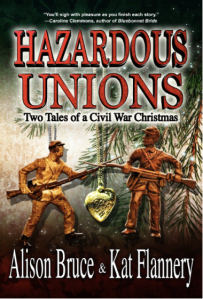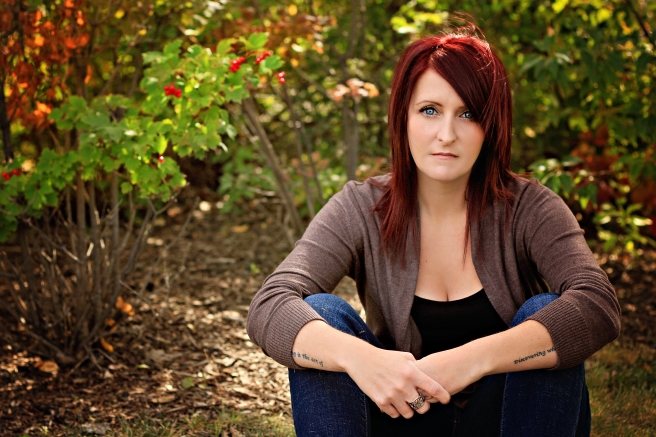This week I have the pleasure of hosting Kat Flannery. Now I’m going admit I haven’t read much romance, but when I read CHASING CLOVERS by Kat Flannery, I was hooked. I was just going to read a couple of pages and get on with my day, but then I couldn’t get off the couch. So it’s with great excitement today that I get to share Kat’s writing tips.
 Before getting to the tips, I have some breaking news. HAZARDOUS UNIONS by Kat Flannery and Alison Bruce is on sale from Nov. 8-12 for $1.99
Before getting to the tips, I have some breaking news. HAZARDOUS UNIONS by Kat Flannery and Alison Bruce is on sale from Nov. 8-12 for $1.99
Now let’s get find out what Kat has to say.
5 Tips to Help You Write a Novel by Kat Flannery
Start with a Bang!
The beginning of a book is where you will set the stakes for your story. How do you do this? Start your story with tension, action, or a problem. I always begin with a conflict. This enables me to introduce the reader to the plot in a way that will grip them and hopefully keep them turning the pages.
In freelance, journalism, short stories, novellas etc. the key ingredient is to hook your reader, just as you’d hook a publisher when querying them; writing a novel is no different. Bring the reader into your story by setting up the action. Keep your reader engaged by giving droplets of information about your character and the plot, or sub plots while building toward the climax of the story.
Backstory and Exposition
As authors we are always told to keep the story moving forward. When telling backstory writers often get confused with how to continue forward when it is a contradiction to the rule. Tell, not show the reader in a paragraph, or page important facts relevant to the character or setting.
Exposition is breaking away from the action to give information. You will need to decide when it is appropriate to place necessary background facts within your novel. This can be tricky, but always remember the story comes first.
Do not bog down the plot with flashbacks of exposition. What I like to always remember for exposition is…telling it when the story allows.
* Three ways to present your exposition is to place it into the scene, put it between scenes, or let a character explain.
Characters
Write them to be tangible. If your character is the antagonist, who is a serial killer, explain how they became this way by foreshadowing, inner dialogue, and actions of other characters. Do not assume your reader doesn’t care who the antagonist is because he is the bad guy. Make it believable, and always ask yourself why, when flushing out character biographies.
Do not change the rules. Characters that don’t follow his/her actions will pull the reader from the story. When you’ve written a character that is shy and timid then all of a sudden she is argumentative and abrasive you will piss your reader off. There is nothing like being stopped dead in a book from poor characterization. If your character starts out meek and mild but you want her to become stronger, build toward it. Do not change her in a few pages. People don’t behave this way. Keep it real.
Sub plots
Well handled, subplots can deepen the story’s background, and be used as pacing to turn the action from a break in the plot. If you’re going to have one or two subplots pertaining to the main characters, start the first one right in the beginning of the story. If you’re choosing to have your subplot around someone other than your protagonist, allow the reader to get to know them first before starting the subplot.
Subplots should be woven throughout the novel, each taking a turn at being the central point of the story. This can be complicated and I’d advise taking notes on subplots so you don’t get confused.
Tie up loose ends. Like plots, subplots need development, crisis, and resolution. Even if the subplot is minimal, treat it the same way you would your plot. Mention to it once in a while throughout the story. Try to write the subplots predicament to be directly involved with the main plot.
Resolution
This is the end of your story. Similar to the beginning, the end will solve the problem you’ve built the reader up to throughout the whole story. Endings can come in three ways, happy, unhappy or both together. It is up to you, and the story you’ve written as to which way you will end things.
The resolution is the winding down of the rocky middle. Here you will resolve the central conflict. The main plot will end, and if you choose to write a series, you can keep a sub plot open, but do not leave the reader guessing on your central plot. Wrap it up!
Happy Writing!
Bio:

Kat Flannery’s love of history shows in her novels. She is an avid reader of historical, suspense, paranormal, and romance.
A member of many writing groups, Kat enjoys promoting other authors on her blog. She’s been published in numerous periodicals throughout her career.
Her debut novel CHASING CLOVERS has been an Amazon bestseller many times. LAKOTA HONOR and BLOOD CURSE (Branded Trilogy) are Kat’s two award-winning novels and HAZARDOUS UNIONS is Kat’s first novella. Kat is currently hard at work on her next book.
You can find Kat here:
***
Next week on Mystery Mondays come on by and find out what C.S. Lakin (novelist and writing coach) has to say.
Thanks for reading…


Excellent post. Checked out your website. Equally excellent. Some great advice.
LikeLiked by 1 person
Thanks Judy. Mystery Mondays has turned out to be an excellent source of writing advice for me too. It’s great to have Kat Flannery here today.
LikeLike
Thank you so much, Kristina for having me on your blog today! And thank you, Judy for the kind words. 🙂
LikeLiked by 1 person
Hi Kat, great to have you here and thanks for sharing your advice with us.
LikeLike
I have met Kat and know she is a fantastic author
LikeLiked by 1 person
I’ve only me her on the internet. Maybe one day I’ll see her in person too.
LikeLike
Thank you, Mandy and right back at ya!! 🙂
LikeLiked by 1 person
Great advice, Kat. The topics you’ve covered stump many writers and your advice is spot on!
LikeLiked by 1 person
Debra, thanks for stopping by. I agree, awesome advice from Kat.
LikeLike
Thanks, Debra!! 🙂
LikeLiked by 1 person
Thank you, Kat! Interesting and useful piece!
LikeLiked by 1 person
Thanks, Jess!! 🙂
LikeLike
Hey Jesse, thanks for stopping by.
LikeLiked by 1 person